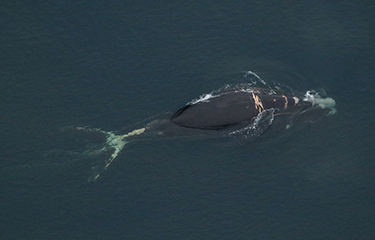NOAA reports entangled adult right whale, dead whale calf

NOAA Fisheries reported it has spotted a “heavily entangled” North Atlantic right whale 20 miles off the coast of Rodanthe, North Carolina – just days after a right whale calf was documented dead near Morehead City, North Carolina.
The entangled whale, NOAA Fisheries said, had several wraps of line around its mouth and tail, with additional line trailing behind it. According to NOAA Fisheries biologists, the images indicate that the entanglement constitutes a “serious injury,” meaning the whale is likely to die from the entanglement.
Entanglement in fishing gear has been a hot-button topic for the U.S. lobster industry, which has been fighting back against new rules that fishery advocates and the state’s congressional delegation say would create dire economic consequences for the industry. Fishermen were granted a six-year reprieve by a last-minute addition to the U.S. Senate’s omnibus funding budget, a move applauded by politicians from the U.S. state of Maine but were denounced by environmental groups.
“Today is a dreadful day for the North Atlantic right whale. The Maine congressional delegation’s irresponsible 11th-hour amendment, which is included in a massive bill to fund the federal government, ensures that critically endangered North Atlantic right whales will not get necessary protections from deadly fishing gear entanglements until at least 2028,” Oceana Campaign Director Gib Brogan said soon after the omnibus was passed. “With an annually declining population now sitting at just around 340 whales, that is too late for the survival of the species.”
Maine's congressional delegation and the lobster fishery have long emphasized that there have been no right whale deaths attributable to Maine lobster gear.
“Maine’s lobstermen and women have long demonstrated their commitment to maintaining and protecting a sustainable fishery in the Gulf of Maine,” Maine's congressional delegation and Maine Governor Janet Mills said. “They have invested in countless precautionary measures to protect right whales, including removing more than 30,000 miles of line from the water and switching to weaker rope to prevent whales from being entangled. And the fact is – there has never been a right whale death attributed to Maine lobster gear.”
Maine Lobstermen's Associaiton Exeuctive Director Patrice McCarron also criticized environmental groups for some of the rhetoric used about right whales in the wake of the omnibus legislations' passage.
"The rhetoric from national advocacy organizations claiming that this important legislation will lead to the 'extinction' of the right whale is contrary to undisputed science, false, and meant to serve only their fringe interests," McCarron said. "The Maine lobster fishery is not driving the right whale population decline, and the species cannot be saved by unlawfully overregulating a fishery that, according to federal data, has never been linked with a right whale death."
News of a newly entangled whale, however, has renewed calls from environmental groups for NOAA to do more, sooner.
“We know that fishing gear entanglements are a top threat to this critically endangered species, and this entanglement is the result of continued mismanagement of this risk,” she said. “The U.S. government should adopt proven safeguards that will eliminate entanglement risk in times and places where right whales swim. Because this species is so depleted, even a single entanglement is tragic. With only around 340 whales remaining, losing a juvenile female sets the North Atlantic right whale population back significantly.”
The news of a newly entangled whale comes just days after a male North Atlantic right whale calf was documented dead on 7 January after being seen alive in 3 January. The whale was spotted by onlookers swimming close to the shore, and it was seen swimming underneath the Morehead City port pier without any other whales present.
An aerial survey team was dispatched to try and identify the potential mother of the calf.
“The aerial survey team widened their search in the hopes of locating and identifying an adult whale that could be the potential mother,” NOAA Fisheries said. “However, no other right whales were found in the area.”
The deaths of two North Atlantic right whales – a species considered critically endangered with just a few hundred members of the species remaining – also came soon after six whales of other species washed up dead in the New York/New Jersey region, with no apparent cause of death in just 33 days.
The deaths started on 5 December when an infant sperm whale was found dead on a beach in Keansburg, New Jersey followed by a dead adult humpback on 6 December, a dead humpback on 10 December, a dead adult sperm whale on 12 December, a young humpback on 23 December, and an adult humpback on 7 January.
Multiple voluntary whale "slow zone" areas have been declared along the U.S. East Coast by NOAA. And NOAA is now considering changes its rules governing North Atlantic right whale vessel-speed regulations.
On the U.S. West Coast, the International Maritime Organization (IMO), the United Nations agency that governs safety and environmental standards for shipping worldwide, recently adopted a U.S. proposal to increase protections for endangered blue, fin, and humpback whales off the coast of the U.S. state of California. The proposal extends vessel traffic lanes around NOAA’s Channel Islands National Marine Sanctuary, an area containing some of the highest densities of commercial maritime traffic in the world.
A 13-nautical-mile extension of vessel traffic lanes, known as the “traffic separation scheme,” will result in vessels lining up for port entry farther west and away from the continental shelf, in deeper waters where there are lower concentrations of whales, according to NOAA. The area vessels must avoid is expanding by more than 2,000 square nautical miles, and will cover approximately 4,475 square nautical miles of important whale feeding habitat off Point Conception and Point Arguello in Santa Barbara County, California, NOAA said.
Photo courtesy of Clearwater Marine Aquarium Research Institute, taken under NOAA permit #20556-01






Share